Click below to jump to an article of interest.
Securing Critical Infrastructure, Industrial Systems
SwRI has developed technology to help government and industry detect cyber threats to industrial networks used in critical infrastructure and manufacturing systems. SwRI funded the research to address emerging cyber threats in the rapidly evolving ecosystem for industrial automation.
“Business trends and new technology — driven in part by a pandemic push toward automation — are revealing more cyber vulnerabilities across industrial systems,” said Dr. Steven Dellenback, vice president of SwRI’s Intelligent Systems Division. “We are proud to support government and industry with multidisciplinary expertise in cybersecurity and automation technologies.”
The team used algorithms to scan for cyber threats across networks that transmit industrial control data for everything from natural gas pipelines to manufacturing robots.
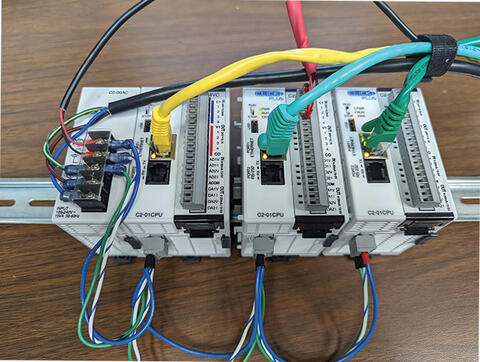
Using a bench test network, SwRI-developed algorithms scanned data packets transferred via the Modbus/TCP protocol for cyberattacks.
The research led to the development of a intrusion detection system (IDS) for industrial control systems (ICS).
“Historically, industrial control systems were not designed with security in mind,” said Ian R. Meinzen, an SwRI intelligent machines engineer who worked on the project. “They had the benefit of an ‘air gap’ where they could operate securely without a connection to information technology (IT) networks.
"Isolating industrial networks from IT networks, however, is no longer an option for modern automation systems that rely on the internet of things (IoT) to transmit vast amounts of data. IoT describes the network of physical objects embedded with sensors and software to connect and exchange data with other devices and systems via communications networks over the internet.
“Connecting IoT devices and other hardware exposes industrial networks to security vulnerabilities,” said Peter Moldenhauer, an SwRI computer scientist specializing in cybersecurity. “Attacks can occur through an IoT device, network protocols and outdated software.”
The SwRI team focused this research on scanning for cyberattacks over the Modbus/Transmission Control Protocol (TCP). Utilities and industry have used this Ethernet-based networking protocol for decades in supervisory controls and data acquisition (SCADA) systems equipment.
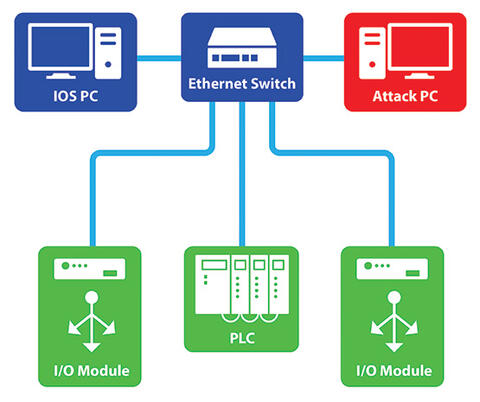
SwRI-designed algorithms detected cyberattacks to an industrial network from a malicious computer. The network utilized the Modbus/TCP protocol to transfer data packets between input/output devices and programmable logic controllers connected via an Ethernet switch.
SwRI researchers originally developed the algorithms to scan Controller Area Network or CAN bus networks used in automotive hardware. They customized cybersecurity algorithms to scan a simulated network equipped with industrial devices before evaluating the new algorithms on a real-world industrial network. The test system used the Modbus/TCP protocol to send data packets over a network. The network featured an Ethernet switch that connected personal computers, programmable logic controllers and input/out modules. Such industrial computing devices send commands and record data for automated robots and mechanized equipment.
“We had to customize the previous algorithms to recognize the different ways the Modbus/TCP protocol grouped data packets in sequences and time signatures,” said Jonathan Esquivel, an SwRI computer scientist.
The adapted algorithms applied to the test network recognized normal Modbus/TCP traffic and identified cyberattack vectors such as out-of-band timing, address probing and data fuzzing/manipulation. The algorithms classify data packets as “regular” when they come from an uncompromised industrial control device or “attack” when the source is an unexpected or compromised device.
Connecting the Dots Between Jovian Moon, Auroral Footprints
On November 8, 2020, NASA’s Juno spacecraft flew through an intense beam of electrons traveling from Ganymede, Jupiter’s largest moon, to its auroral footprint on the gas giant. SwRI scientists used data from Juno’s payload to study the charged particles traveling along the magnetic field connecting Ganymede to Jupiter while, at the same time, recording pictures of Jupiter’s auroras.
“Jupiter’s most massive moons each create their own auroras on Jupiter’s north and south poles,” said Dr. Vincent Hue, lead author of a paper outlining the results of this research. “Each auroral footprint, as we call them, is magnetically connected to their respective moon, kind of like a magnetic leash connected to the moon glowing on Jupiter itself.”
Like the Earth, Jupiter experiences auroral light around the polar regions. However, Jupiter’s auroras are significantly more intense than Earth’s, and unlike Earth, Jupiter’s largest moons also create their own auroras on Jupiter. The Juno mission to Jupiter is led by SwRI’s Dr. Scott Bolton. From its polar orbit, the Juno spacecraft flew through the electron “thread” connecting Ganymede with its associated auroral footprint.
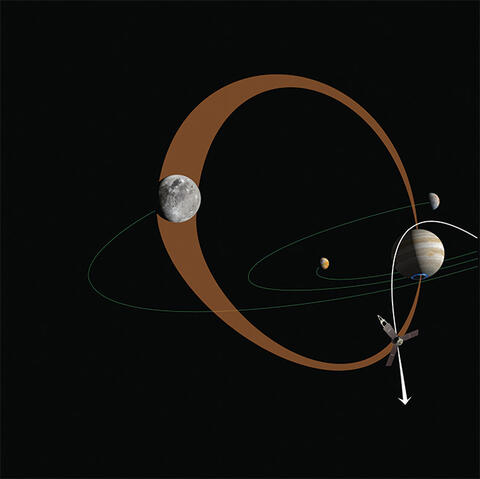
Courtesy of NASA/SwRI/JPL-Caltech/Malin Space Science Systems/Kevin M. Gill/Italian Space Agency/Italian National Institute For Astrophysics/Björn Jónsson/Uliége/Bertrand Bonfond/Vincent Hue
NASA’s Juno spacecraft flew through the intense beam of electrons traveling from Ganymede, Jupiter’s largest moon, to its auroral footprint on the gas giant. SwRI scientists used the resulting data to connect the particle population traveling along the beam with associated auroral emissions to unveil the mysterious processes creating the shimmering lights.
Ganymede is the only moon in our solar system that has its own magnetic field. Its mini-magnetosphere interacts with Jupiter’s massive magnetosphere, creating waves that accelerate electrons along the gas giant’s magnetic field lines, which can be directly measured by Juno.
Two SwRI-led instruments on Juno, the Jovian Auroral Distributions Experiment (JADE) and the Ultraviolet Spectrometer (UVS) provided key data for this study, which was also supported by Juno’s magnetic field sensor built at NASA’s Goddard Space Flight Center.
“JADE measured the electrons traveling along the magnetic field lines, while UVS imaged the related auroral footprint spot,” said SwRI’s Dr. Thomas Greathouse, a co-author on this study.
In this way, Juno is both able to measure the electron “rain” and immediately observe the UV light it creates when it crashes into Jupiter. Previous Juno measurements showed that large magnetic perturbations accompanied the electron beams causing the auroral footprint. This time, however, Juno did not observe similar perturbations with the electron beam.
“If our interpretation is correct, this is a confirmation of a decade-old theory that we put together to explain the morphology of the auroral footprints,” said Dr. Bertrand Bonfond of the Liège University in Belgium, a co-author of the study. The theory suggests that electrons accelerated in both directions create the multi-spot dance of auroral footprints.
“The Jupiter-Ganymede relationship will be further explored by Juno’s extended mission, as well as the forthcoming JUICE mission from the European Space Agency,” Hue said. “SwRI is building the next generation of UVS instrumentation for the mission.”
A paper describing this research was published in Geophysical Research Letters and can be accessed at https://doi.org/10.1029/2021GL096994. To view a movie about this research, see: https://youtu.be/xGUtx0IvYZI
DAIS Crime-Busting Software System
In the mid-2000s, SwRI developed the Digital Automotive Image System (DAIS) to assist in the forensic investigation of crimes, providing automotive images and associated technical specifications of vehicles. The system allows law enforcement personnel to search a database of vehicles to find a particular car or cars and print a high-quality 8x10 image of the vehicle or quickly create a customized be-on-the-lookout (BOLO) poster. The database can be searched by year, make, model, class/type, door number, features and any combination thereof. DAIS has helped solve bank robberies, child abductions, missing persons and various other cases. SwRI provides regular updates to the software to include new vehicles. The FBI provides DAIS free of charge to law enforcement via the Law Enforcement Enterprise Portal (LEEP).

Multiple Eruptions Likely Behind Pluto’s Giant Ice Volcanos
SwRI scientists led a New Horizons mission team that determined multiple episodes of cryovolcanism may have created interesting surface structures on Pluto, the likes of which are not seen anywhere else in the solar system. Material expelled from below the surface of this distant, icy planet could have created a region of large domes and rises flanked by hills, mounds and depressions.
“The particular structures we studied are unique to Pluto, at least so far,” said SwRI’s Dr. Kelsi Singer, New Horizons deputy project scientist and lead author of the paper published in Nature Communications. “Rather than erosion or other geologic processes, cryovolcanic activity appears to have extruded large amounts of material onto Pluto’s exterior and resurfaced an entire region of the hemisphere New Horizons saw up close.”
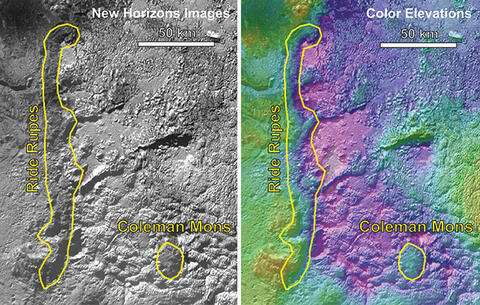
Courtesy of NASA/Johns Hopkins University APL/SwRI/Isaac Herrera/Kelsi Singer
The New Horizons team proposed names for two structures in the cryovolcanic region honoring aviation pioneers Bessie Coleman, the first African American and Native American woman to earn a pilot’s license, and Sally Ride, the first American woman in space.
Singer’s team analyzed the geomorphology and composition of an area located southwest of Pluto’s bright, icy “heart,” Sputnik Planitia. The cryovolcanic region contains multiple large domes, ranging from about one-half to 4 miles tall and 18 to 60 miles across, that sometimes merge to form more complex structures. Irregular interconnected hills, mounds and depressions, called hummocky terrain, cover the sides and tops of many of the larger structures. Few, if any, craters exist in this area, indicating it is geologically young. The largest structures in the region rival the Mauna Loa volcano in Hawaii.
Even with the addition of ammonia and other antifreeze-like components that lower the melting temperature of water ices — a process similar to the way road salt inhibits ice from forming on streets and highways — the extremely low temperatures and atmospheric pressures on Pluto rapidly freeze liquid water on its surface.
Because these are young geologic terrains and large amounts of material were required to create them, it is possible that Pluto’s interior structure retained heat up until the relatively recent past, enabling water-ice-rich materials to be deposited onto the surface. Cryovolcanic flows capable of creating the large structures could have occurred if the material had a toothpaste-like consistency, flowing somewhat like solid ice glaciers on Earth or creeping from beneath a frozen shell.
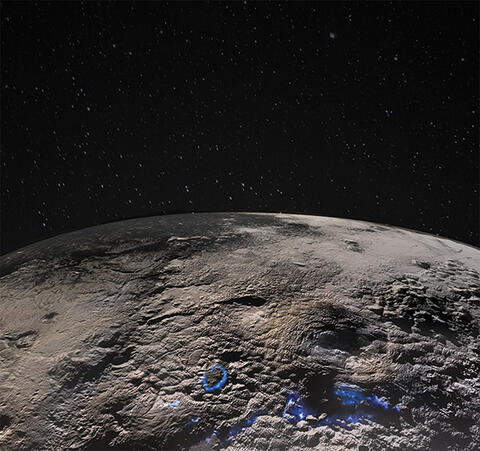
Courtesy of NASA/Johns Hopkins University APL/SwRI/Isaac Herrera/Kelsi Singer
Cryovolcanic activity most likely created these unique structures on Pluto. The surface and atmospheric hazes of Pluto are shown here in greyscale, with an artistic interpretation of how past volcanic processes may have operated superimposed in blue
“One of the benefits of exploring new places in the solar system is that we find things we weren’t expecting,” said Singer. “These giant, strange-looking cryovolcanoes observed by New Horizons are a great example of how we are expanding our knowledge of volcanic processes and geologic activity on icy worlds.”
Images obtained in 2015 by the New Horizons spacecraft revealed diverse geological features populating across Pluto, including mountains, valleys, plains, and glaciers. They were particularly intriguing because the frigid temperatures at Pluto’s distance were expected to produce a frozen, geologically inactive world.
“This newly published work is truly landmark, showing once again how much geologic personality Pluto has for such a small planet, and how it has been incredibly active over long periods,” said New Horizons Principal Investigator Dr. Alan Stern of Southwest Research Institute. “Even years after the flyby, these new results by Singer and her coworkers show that there’s much more to learn about the marvels of Pluto than we imagined before it was explored up close.”
New Horizons was NASA’s mission to make the first exploration of Pluto and its system of five moons. The paper “Large-scale cryovolcanic resurfacing on Pluto” by Singer and the New Horizons team is available in Nature Communications.
Creating Advanced Burner to Reduce Methane Emissions
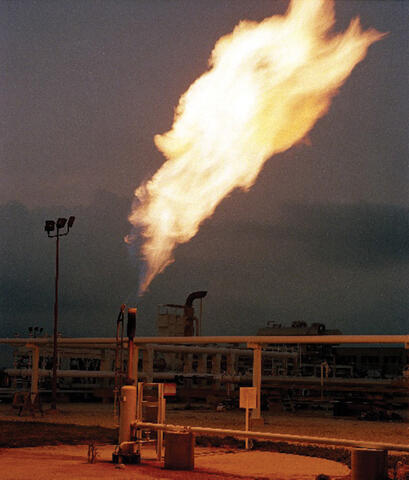
SwRI’s MRF flare, above, will play a central role in a new ARPA-E project to create an advanced burner that will eliminate 99.5% of the methane in gas flares used by the oil and gas industry.
In collaboration with the University of Michigan (UM), SwRI is using additive manufacturing and machine learning to create an advanced burner capable of eliminating virtually all the methane vented during oil production. Burners currently used in the field typically perform below target specifications, especially under crosswind conditions, which results in a significant portion of this powerful greenhouse gas escaping into the atmosphere.
During oil production, producers encountering pockets of methane typically use flare stacks to burn off the vented gas. However, when winds blow across conventional open flame burners, 40% or more of the gas escapes into the air. Methane’s global warming effect is significantly greater than that of carbon dioxide on a per-unit basis, so flaring reduces overall climate change potential.
“We are working to create a burner capable of achieving high methane destruction efficiency and combustion stability, eliminating 99.5% of vented methane, even in challenging field conditions,” said SwRI Research Engineer Luis Gutierrez, one of the project’s leaders. “This burner will be a vast improvement over today’s conventional flare technology.”
Gutierrez is working with Dr. Margaret Wooldridge, an Arthur F. Thurnau Professor of Mechanical Engineering at UM and leader of the Wooldridge Combustion Laboratory. She has extensive experience in using advanced engineering methods such as machine learning to optimize combustion systems and reduce emissions. Additive manufacturing supports the development of burners with complex geometries to enhance the efficacy and robustness of the combustion process in gas flares. Using computational fluid dynamics, machine learning and multiscale testing, the team will explore less conventional solutions to optimize fluid dynamics and gas mixing in a novel burner design that lowers methane emissions.
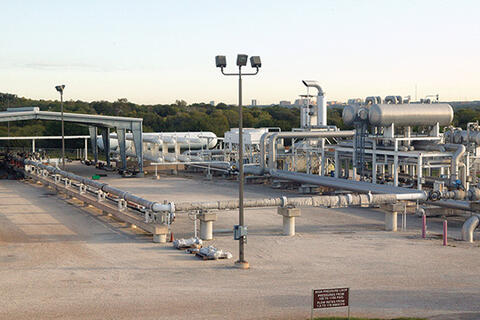
SwRI’s Metering Research Facility will serve as a testbed for a collaborative project with the University of Michigan to create an advanced burner that will eliminate virtually all the methane vented during oil and gas production.
The project will take advantage of SwRI’s Metering Research Facility (MRF), a world-class, natural gas flow measurement testbed, with the most accurate, controllable and flexible research capabilities in the industry. MRF provides the realistic conditions needed to test the effectiveness of the burner’s geometry. Additionally, engineers will fabricate the burners in SwRI’s metal additive manufacturing facilities.
The three-year, $2.9 million project is funded by the U.S. Department of Energy’s Advanced Research Projects Agency–Energy (ARPA-E) Reducing Emissions of Methane Every Day of the Year (REMEDY) program. It is one of several projects funded in support of the U.S. Methane Emissions Reduction Action Plan, announced at the 2021 United Nations Climate Change Conference. The plan seeks to reduce methane emissions and promote American innovation and manufacturing of new technologies to achieve climate goals.
In Search of Other Earths
As the scientific community searches for worlds orbiting nearby stars that could potentially harbor life, new SwRI-led research suggests that younger rocky exoplanets are more likely to support temperate, Earth-like climates.
In the past, scientists have focused on planets situated within a star’s habitable zone, where it is neither too hot nor too cold for liquid surface water to exist. Today, we know sustaining temperate climates also requires a planet have sufficient heat to power a planetary-scale carbon cycle. A key source of this energy is the decay of the radioactive isotopes of uranium, thorium and potassium.
“We know these radioactive elements are necessary to regulate climate, but we don’t know how long these elements can do this, because they decay over time,” said Dr. Cayman Unterborn, lead author of an Astrophysical Journal Letters paper about the research.
Studying exoplanets is challenging. Today’s technology cannot measure the composition of an exoplanet’s surface, much less that of its interior. Scientists can, however, measure the abundance of elements in a star spectroscopically by studying how light interacts with the elements in a star’s upper layers. Using these data, scientists can infer what a star’s orbiting planets are made of using stellar composition as a rough proxy for its planets.
“Using host stars to estimate the amount of these elements that would go into planets throughout the history of the Milky Way, we calculated how long we can expect planets to have enough volcanism to support a temperate climate before running out of power,” Unterborn said. “Under the most pessimistic conditions we estimate that this critical age is only around 2 billion years for an Earth-mass planet and reaching 5–6 billion years for higher-mass planets under more optimistic conditions.”
The Astrophysical Journal Letters paper describing this research is titled “Mantle Degassing Lifetimes through Galactic Time and the Maximum Age Stagnant-lid Rocky Exoplanets can Support Temperate Climates” and can be accessed at https://doi.org/10.3847/2041-8213/ac6596.

Courtesy of NASA/JPL-Caltech
While TRAPPIST-1 is home to the largest known group of roughly Earth-sized planets in a single stellar system, these worlds are likely too old to support a temperate climate today, based on a recent SwRI-led study.
Revitalizing Clean, Efficient Hydrogen Engine Concepts
In pursuit of zero carbon emissions, SwRI is investigating four concepts for converting existing internal combustion (IC) engine designs to burn hydrogen cleanly and efficiently.
Government and industry researchers are working to transition transportation energy usage away from fuels that emit carbon dioxide (CO₂) — a greenhouse gas (GHG) that contributes to climate change — to hydrogen and other alternative fuels that emit less CO₂ on a well-to-wheel basis. According to the U.S. Environmental Protection Agency, transportation alone produced 29% of total U.S. GHG emissions in 2019, the largest share.
In the late 2000s, the U.S. Department of Energy and numerous automakers funded hydrogen IC engine development. To build on this earlier research, SwRI ran simulations of four novel approaches for using spark-ignited (SI) combustion of hydrogen to fuel an IC engine. That research demonstrated a hydrogen-fueled SI engine that could achieve 45% brake thermal efficiency (BTE) in the laboratory, which was competitive with diesel engines at the time. Today’s gasoline engines typically have BTEs of 30–43% and modern diesel engines have BTEs from 42– 50%. By comparison, each of SwRI’s simulated approaches shows a development path to achieve at least 50% BTE.

“Higher brake thermal efficiency translates to lower fuel consumption,” said Dr. Thomas Briggs, part of the SwRI research team, which includes Dr. Graham Conway (pictured). “None of the simulations we completed represent fully optimized calibrations for a combustion system, but they all show thermal efficiencies comparable to a baseline diesel engine, with nitrogen oxides (NOx) emissions consistent with diesel combustion, but no carbon monoxide, hydrocarbon, soot or CO₂ emissions. It is very promising.”
SwRI recently patented technology that improves hydrogen fuel injection management, optimizing air-fuel mixtures and minimizing the risk of pre-ignition. The team is working with engine suppliers to acquire a suitable fuel injector to move into the second phase of their research and is well positioned to lead a shift to cleaner hydrogen-fueled vehicles.
Ultraviolet Instrument to Play Integral Part in NASA’s Europa Clipper Mission
An ultraviolet spectrograph (UVS) designed and built by SwRI was the first scientific instrument to be delivered for integration onto NASA’s Europa Clipper spacecraft. Scheduled to launch in 2024 and arrive in the Jovian system by 2030, the Europa Clipper spacecraft will conduct a detailed reconnaissance of Jupiter’s moon Europa and investigate whether it harbors conditions suitable for life.
Europa-UVS is one of nine science instruments in the mission payload. The instrument collects UV light and creates images to help determine the composition of Europa’s atmospheric gases and surface materials. The Europa Clipper spacecraft will orbit Jupiter and perform repeated close flybys of the icy moon. Previous observations show strong evidence for a subsurface ocean of liquid water that could host conditions favorable for life.

Image Courtesy of NASA/JPL-Caltech
“It has been a huge team effort to get Europa-UVS built, tested and delivered,” said Matthew Freeman, project manager for Europa-UVS and a group leader in SwRI’s Space Science and Engineering Division. “Europa-UVS is the sixth in a series of SwRI-built ultraviolet spectrographs, and it benefits greatly from the design experience gained by our team from the Juno-UVS instrument, which is currently operating in Jupiter’s harsh radiation environment.”
In addition to performing atmospheric studies, Europa-UVS will also search for evidence of geysers erupting from within Europa.
“Europa-UVS will hunt down potential plumes erupting from Europa’s icy surface and study them,” said SwRI’s Dr. Kurt Retherford, principal investigator for the UVS instrument. “Europa-UVS will search for and characterize plumes in terms of activity and the nature of subsurface water reservoirs. We will study how the plumes behave — when they start, stop and expand outward far into space.”
New Space Integration Facility Supports Smallsat Development
SwRI has added a 74,000- square-foot Space System Integration Facility to its San Antonio headquarters. The SwRI facility supports the rapid design, assembly and testing of spacecraft, particularly small satellites for emerging “new space” applications, including support for commercial clients and the U.S. Department of Defense.
According to one industry forecast, nearly 12,000 small satellites — defined in this case as satellites with masses under 500 kilograms — will be placed in orbit between 2018 and 2030, an average of nearly 1,000 small satellites annually. SwRI serves as a trusted leader for this rapidly advancing industry, providing technology development and innovation.

“After 40 years as one of the leading space science and engineering programs, SwRI now offers a new state-of-the-art spacecraft assembly, integration and test facility, designed for working with the latest launch providers,” said Steve Diamond, a senior program manager in SwRI’s Space Science and Engineering Division. “Using digital design and design-to-manufacturing (D2M) processes, we can rapidly field mission prototypes, then collaborate with industry to meet low-Earth orbit constellation production requirements. Our work with emerging launch providers allows us to create a unique capability for deploying smallsat assets using launch campaigns measured in days instead of months.”
The new building includes nearly 20,000 square feet of integration space, including a range of cleanroom facilities. In addition, the new building houses a nearly 11,000-square-foot environmental testing facility that includes a thermal vacuum chamber capable of testing multiple spacecraft at once, a shielded electromagnetic interference enclosure and a high-decibel acoustic test chamber.
“Our digital design ethos supports the integration of mobile launch capabilities and scaled serial production,” Diamond said. “The building design supports multiple levels of security, accommodating multiple programs and customers in parallel.”
SwRI offers comprehensive vertical mission capabilities in a single organization, including design, fabrication, test, launch and operations support.
Evidence for an Internal Ocean in Small Saturn Moon
An SwRI scientist set out to prove that the tiny, innermost moon of Saturn was a frozen inert satellite and instead discovered compelling evidence that Mimas has a liquid internal ocean. In the waning days of NASA’s Cassini mission, the spacecraft identified a curious libration, or oscillation, in the moon’s rotation, which often points to a geologically active body able to support an internal ocean.

Image Courtesy of NASA / JPL-Caltech / Space Science Institute
An SwRI scientist has discovered that Saturn’s small moon Mimas (top) likely has something in common with its larger neighbor Enceladus: an internal ocean beneath a thick icy surface.
“If Mimas has an ocean, it represents a new class of small, ‘stealth’ ocean worlds with surfaces that do not betray the ocean’s existence,” said SwRI’s Dr. Alyssa Rhoden, a specialist in the geophysics of icy satellites.
One of the most profound discoveries in planetary science over the past 25 years is that worlds with oceans beneath layers of rock and ice are common in our solar system. Such worlds include the icy satellites of the giant planets, such as Europa, Titan and Enceladus, as well as distant planets like Pluto. Worlds like Earth with surface oceans must reside within a narrow range of distances from their stars to maintain the temperatures that support liquid oceans. Interior water ocean worlds (IWOWs), however, are found over a much wider range of distances, greatly expanding the number of habitable worlds likely to exist across the galaxy.
“Because the surface of Mimas is heavily cratered, we thought it was just a frozen block of ice,” Rhoden said. “IWOWs, such as Enceladus and Europa, tend to be fractured and show other signs of geologic activity. Turns out, Mimas’ surface was tricking us, and our new understanding has greatly expanded the definition of a potentially habitable world in our solar system and beyond.”
Evaluating Mimas’ status as an ocean moon would benchmark models of its formation and evolution.
“This would help us better understand Saturn’s rings and mid-sized moons as well as the prevalence of potentially habitable ocean moons, particularly at Uranus,” Rhoden said. “Mimas is a compelling target for continued investigation.” Rhoden is co-leader of NASA’s Network for Ocean Worlds Research Coordination Network and previously served on the National Academies’ Committee on Astrobiology and Planetary Science. A paper describing this research was published online in Icarus and can be accessed at https://doi.org/10.1016/j.icarus.2021.114872 .
CAT-DEF Reduces NOx, CO₂ Emissions
SwRI’s patented and award-winning CAT-DEF™ technology successfully reduces heavy-duty diesel engine nitrogen oxide (NOx) emissions to meet California Air Resources Board (CARB) 2027 standards. SwRI’s novel technology decreases NOx and carbon dioxide emissions for diesel engines by significantly reducing undesirable deposit formation in exhaust systems.
CAT-DEF, which stands for Catalyzed Diesel Exhaust Fluid, is an SwRI-developed catalyst- and surfactant-modified diesel exhaust fluid (DEF) solution. Today’s diesel engines use selective catalytic reduction (SCR), an advanced emissions control system, to abate NOx emissions. DEF is injected into the exhaust stream and ideally decomposes to form ammonia, which reacts with NOx on the catalyst to form N₂ and H₂O.

“Although DEF technology has been utilized for more than a decade, the highest emissions control efficiencies could never be realized because DEF can create potentially harmful deposits in the exhaust system, particularly when the engine is operated at low loads and temperatures,” said Dr. Charles E. Roberts Jr., director of SwRI’s Commercial Vehicle Systems Department. “A combination of surface-active agents and heterogenous catalysts blended into CAT-DEF reduces deposits by 90% with potential reductions up to 98%.”
At temperatures below 250°C, deposits forming in aftertreatment systems can severely limit low-temperature NOx conversion and increase fuel consumption as high-temperature engine operations are required to remove the deposits.
SwRI’s CAT-DEF technology is currently available to license. The novel innovation is backwards-compatible and can be used in existing engines as a deposit reduction solution. For future applications required to meet more stringent regulatory requirements, the award-winning CAT-DEF solution competes with higher-cost engine hardware modifications currently being considered by the diesel engine industry and DEF manufacturers.
Slush Brines Possible on Mars
An SwRI scientist measured the properties of ice-brine mixtures as cold as -145 degrees Fahrenheit to help confirm that salty water likely exists between grains of ice or sediment under the ice cap at Mars’ south pole. Laboratory measurements conducted by SwRI geophysicist Dr. David Stillman support theoretical explanations for bright reflections detected using subsurface sounding radar aboard ESA’s Mars Express orbiter.
Conventional models assumed the Mars south polar cap experiences temperatures much lower than the melting point of water. Clay, hydrated salts and saline ices have been proposed as potential explanations for the source of the bright basal reflections, but Stillman’s findings may suggest a different explanation altogether.

An SwRI scientist studied the antifreeze properties of exotic salts that exist on Mars, which could allow brines to remain liquid down to -103 degrees Fahrenheit. The studies show how a mile below the Martian south polar cap, brines between the grains of ice or sediments could produce the strong reflections detected by the radar instrument aboard ESA’s Mars Express orbiter
“Lakes of liquid water actually exist beneath glaciers in Arctic and Antarctic regions, so we have Earth analogs for finding liquid water below ice,” said Stillman, a co-author of a paper describing these findings. “The exotic salts that we know exist on Mars have amazing ‘antifreeze’ properties allowing brines to remain liquid down to -103 degrees Fahrenheit.” For this project, Stillman measured the properties of perchlorate brines in an SwRI environmental chamber that produces near-liquid-nitrogen temperatures at Mars-like pressures.
“The research showed that we don’t have to have lakes of perchlorate and chloride brines, but that these brines could exist between the grains of ice or sediments and are enough to exhibit a strong radar reflection,” Stillman said. “This is similar to how seawater saturates grains of sand at the shoreline or how flavoring permeates a slushie, but at -103 degrees Fahrenheit and below a mile of ice near the South Pole of Mars.”
The search for water in the cosmos is rooted in searching for potential habitability, because all known life requires water.
“In this case ‘following the water’ has led us to places so cold that life as we know it couldn’t flourish,” Stillman said. “But it’s still interesting, and who knows what evolutionary paths extraterrestrial life may have taken?”
The lead authors for an Earth and Planetary Sciences Letters paper describing this research are from Roma Tre University in Rome, Italy. It can be accessed online at ScienceDirect https://doi.org/10.1016/j.epsl.2022.117370 .
SwRI, UT Austin Energize Collaboration
Southwest Research Institute and The University of Texas at Austin have created The Energize Program, a new opportunity to enhance greater scientific collaboration between the two institutions.
“The Energize Program will bring together the capabilities, facilities and expertise from SwRI as well as UT Austin’s Energy Institute and Hildebrand Department of Petroleum and Geosystems Engineering in an effort to strengthen research efforts that benefit humankind,” said SwRI Executive Vice President and COO Walt Downing. “This is a tremendous opportunity for our two institutions to work together to solve some of the most challenging energy issues we face today.”
Two programs are available, with funds provided by SwRI and UT. Some can include contributions from industry affiliates or institutions. Energize projects will include at least one principal investigator from each institution.
One program will fund up to three two-year projects in any field of energy research focused on decarbonization and climate security. The other will fund up to two two-year projects in any field of energy-related research, including oil and gas, renewable resources, hydrogen, carbon storage and geothermal energy.
SwRI is a leader in energy research solutions that improve the efficiency, performance and safety of energy across fuel cycles and supply chains. Institute researchers are working to improve the efficiency of conventional power generation and aid the integration of renewable resources. SwRI’s work in battery chemistries and electric vehicles has developed new and improved grid-scale energy storage systems. The Institute’s San Antonio campus is home to the Supercritical Transformational Electric Power (STEP) Pilot Plant, a 10-megawatt supercritical carbon dioxide (sCO2) facility designed to demonstrate the next generation of higher efficiency, lower-cost electric power technology.
Simulation Shows Solar System Forming from Rings
An SwRI scientist contributed to a new solar system formation model that explains the existing inner planets and asteroid belt. Dr. Rogerio Deienno, who specializes in celestial mechanics and dynamical astronomy, and his colleagues developed a model where three rings of planetesimals, the building blocks for planets, would form from the swirling disk of gas and dust around the Sun known as the solar nebula.

Courtesy of Alma (ESO/NAOJ/NRAO)
“As dust particles move slightly faster than the gas around them, they feel a headwind, lose energy and drift very quickly toward the star,” said Deienno, who contributed to a Nature Astronomy paper discussing this research. “At ‘pressure bumps’ — regions in the disk usually associated with localized changes in disk composition and the size of dust grains — gas pressure increases, gas molecules move faster and solid particles stop feeling the headwind. That allows dust particles to accumulate at these pressure bumps forming rings separated by gaps.”
The three rings in the Sun’s natal disk are associated with three pressure bumps at different sublimation fronts, corresponding to temperatures and distance from the star. Sublimation fronts are regions in the disk where materials of a given chemical composition become vapor.
“As time goes by, the disk temperature cools,” Deienno said. “This cooling process causes the pressure bumps to migrate toward the Sun, with the first planetesimals forming at the outer edge of each ring.”
Using supercomputers, the researchers performed a variety of simulations that captured how our inner solar system formed right down to the slightly different chemical compositions and masses of Venus, Earth and Mars. They formed from the innermost of the three rings, with Earth and Venus analogs collecting the most materials forming the bulk from the center of the ring, whereas Mars was built from materials in the more sparsely populated regions from the edge of the ring.
The Nature Astronomy paper was published online December 30 and can be accessed online at https://doi.org/10.1038/s41550-021-01557-z .
Lucy’s Long-Distance Lunar Eclipse Observation
The NASA Lucy mission, led by SwRI’s Dr. Hal Levison, observed the May 2022 total lunar eclipse from a unique vantage point 64 million miles (100 million km) from the Earth.
For a few hours on May 15, the Earth cast its shadow over the Moon. This total lunar eclipse was visible over much of the United States, but it was also visible from deep space. Despite being so far away, the Lucy spacecraft was able to use its high-resolution imaging instrument to watch the Moon pass into the shadow of the Earth, disappearing from view.
”While total lunar eclipses aren’t that rare — they happen every year or so — it isn’t that often that you get a chance to observe them from an entirely new angle,” said Levison. “When the team realized Lucy had a chance to observe this lunar eclipse as a part of the instrument calibration process, everyone was incredibly excited.”

Courtesy of NASA/Goddard/APL/SwRI
The May 2022 total lunar eclipse was imaged by the L’LORRI black-and-white camera from aboard the Lucy spacecraft 64 million miles from Earth. The Earth is seen on the left, while the Moon (on the right) disappears as it passes into the Earth’s shadow (bottom panel). The Moon, which is much fainter than the Earth, has been brightened sixfold to make it more visible.
The Lucy spacecraft launched on October 16, 2021. The spacecraft trajectory has it traveling back toward the Earth for a gravity assist to help propel it on its journey to the Trojan asteroids. This previously unexplored population of asteroids that lead and follow Jupiter in its orbit around the Sun are “fossils” of planet formation; they likely hold important clues to help us understand the history of our Solar System.
Lucy’s L’LORRI instrument, a high-resolution, black-and-white camera, took 86 one-millisecond exposures to create a time-lapse video of the first half of the total lunar eclipse. A movie made from these images has been viewed more than 72,000 times on SwRItv, the Institute’s YouTube channel. See https://youtu.be/0c3ak2_JVts.
“Capturing these images really was an amazing team effort,” said SwRI’s Dr. John Spencer. “And all this had to be done while operating the spacecraft in a very tricky environment.”
Designed to operate at the Trojans more than five times farther from the Sun than the spacecraft is now, the spacecraft only viewed the first half of the eclipse to avoid the risk of overheating.
Powerful Microscope Expands Characterization Capabilities
SwRI is now home to a field emission scanning electron microscope, a powerful characterization tool to study a wide range of materials, including thin films and nanomaterials. The microscope’s powerful magnification capabilities can produce clear, sharp images of objects magnified over a million times. Additionally, an onboard energy-dispersive X-ray spectrometer enables localized chemical analysis of the materials being imaged.
“This exceptional new tool will allow us to image and chemically characterize materials at much higher magnifications than we could previously,” said John Macha, manager of SwRI’s Materials Science and Failure Analysis Section.

The microscope will be especially useful to SwRI’s Surface Engineering Laboratory, where engineers use various processes to modify the surface of materials for improved properties. The microscope will support a broad range of programs including graphene synthesis research, allowing visualization of the material’s unique structure. The microscope will also support the evaluation of thin films composed of high entropy alloys, which are formed by mixing equal or relatively large proportions of five or more elements.
“This new microscope will serve researchers across many different disciplines,” Macha said. “For instance, our space scientists will use it to evaluate ultrathin films and other coatings for spacecraft instrumentation. Hypersonics researchers can evaluate how different coating technologies protect objects traveling extremely fast, to prevent them from deteriorating.”
This powerful microscope will also expand SwRI’s failure analysis capabilities, which include studying the root cause of equipment failures for the power generation, aerospace and transportation industries. Engineers will use the instrument to zoom in on extremely fine fracture features to assess the damage mechanisms that led to failure.
“We’re excited about the new applied research opportunities this instrument will bring — the ones we’ve identified as well as potential new ones waiting to be discovered,” he said.

